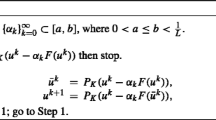Abstract
Iterative numerical algorithms for variational inequalities are systematically constructed from fixed-point problem characterizations in terms of resolvent operators. The applied method is the one introduced by Gabay in [Ga], used here in the context of discrete variational inequalities, and with the emphasis on mixed finite element models. The algorithms apply to nonnecessarily potential problems, generalizing primal and mixed Uzawa and augmented Lagrangian-type algorithms. They are also identified with Euler and operator splitting methods for the time discretization of evolution first-order problems.
Similar content being viewed by others
References
Alduncin G (1987) Duality and variational principles of potential boundary value problems. Comput Methods Appl Mech Engrg 64: 469–485
Alduncin G (1989) Subdifferential and variational formulations of boundary value problems. Comput Methods Appl Mech Engrg 72: 173–186
Alduncin G (1992) Augmented Lagrangian methods for the quasistatic viscoelastic two-body contact problem with friction. In: Contact Mechanics (Curnier A, ed). Presses Polytechniques et Universitaires Romandes, Lausanne, pp 337–360
Alduncin G (1993) Primal and mixed upwind finite element approximations of control advection-diffusion problems. Comput Mech 11: 93–106
Brezis H (1973) Opérateurs Maximaux Monotones. North-Holland, Amsterdam
Blanchard D, Le Tallec P (1986) Numerical analysis of the equations of small strains quasistatic elastoviscoplasticity. Numer Math 50: 147–169
Bermúdez A, Moreno C (1981) Duality methods for solving variational inequalities. Comput Math Appl 7: 43–58
Bertsekas D P, Tsitsiklis J N (1989) Parallel and Distributed Computation, Numerical Methods. Prentice-Hall, Englewood Cliffs, NJ
Eckstein J, Bertsekas D P (1992) On the Douglas-Rachford splitting method and the proximal point algorithm for maximal monotone operators. Math Programming 55: 293–318
Ekeland I, Temam R (1973) Analyse Convexe et Problèmes Variationnelles. Dunod, Gauthier-Villars, Paris
Fortin M (1976) Minimization of some non-differentiable functionals by the augmented Lagrangian method of Hestenes and Powell. Appl Math Optim 2: 236–250
Fortin M, Glowinski R, eds (1982) Méthodes de Lagrangien Augmenté: Applications à la Résolution Numérique de Problèmes aux Limites. Dunod-Bordas, Paris
Gabay D (1982) Application de la méthode des multiplicateurs aux inéquations variationnelles. In: Méthodes de Lagrangien Augmenté (Fortin M, Glowinski R, eds). Dunod-Bordas, Paris, pp 279–307
Glowinski R (1984) Numerical Methods for Nonlinear Variational Problems. Springer-Verlag, New York
Glowinski R, Le Tallec P (1989) Augmented Lagrangian and Operator-Splitting Methods in Nonlinear Mechanics. SIAM, Philadelphia, PA
Glowinski R, Lions J L, Trémolièrs R (1981) Numerical Analysis of Variational Inequalities. North-Holland, Amsterdam
Gabay D, Mercier B (1976) A dual algorithm for the solution of nonlinear variational problems via finite element approximations. Comput Math Appl 2: 17–40
Lions P L (1978) Une méthode itérative de resolution d’une inequation variationnelle. Israel J Math 31: 204–208
Le Tallec P (1990) Numerical Analysis of Viscoelastic Problems. Masson, Paris; Springer-Verlag, Berlin
Le Tallec P (1994) Domain decomposition methods in computational mechanics. Comput Mech Adv 1: 121–220
Lions P L, Mercier B (1979) Splitting algorithms for the sum of two nonlinear operators. SIAM J Numer Anal 16: 964–979
Moreau J J (1965) Proximité et dualité dans une espace hilbertiane. Bull Soc Math France 93: 273–299
Mosco U (1972) Dual variational inequalities. J Math Anal Appl 40: 202–206
Pazy A (1979) Semi-groups of nonlinear contractions and their asymptotic behaviour. In Nonlinear Mechanics (Knops R J, ed). Pitman, London, pp 36–134
Rockafellar R T (1976) Monotone operators and the proximal point algorithm. SIAM J Control Optim 14: 877–898
Tseng P (1991) Applications of splitting algorithm to decomposition in convex programming and variational inequalities. SIAM J Control Optim 29: 119–138
Tseng P, Bertsekas D P (1993) On the convergence of the exponential multiplier method for convex programming. Math Programming 60: 1–19
Author information
Authors and Affiliations
Additional information
Communicated by R. Temam
Rights and permissions
About this article
Cite this article
Alduncin, G. On Gabay’s algorithms for mixed variational inequalities. Appl Math Optim 35, 21–44 (1997). https://doi.org/10.1007/BF02683318
Accepted:
Issue Date:
DOI: https://doi.org/10.1007/BF02683318
Key Words
- Proximal-point algorithms
- Operator-splitting methods
- Variational inequalities
- Initial and boundary-value constrained problems
- Mixed finite elements



